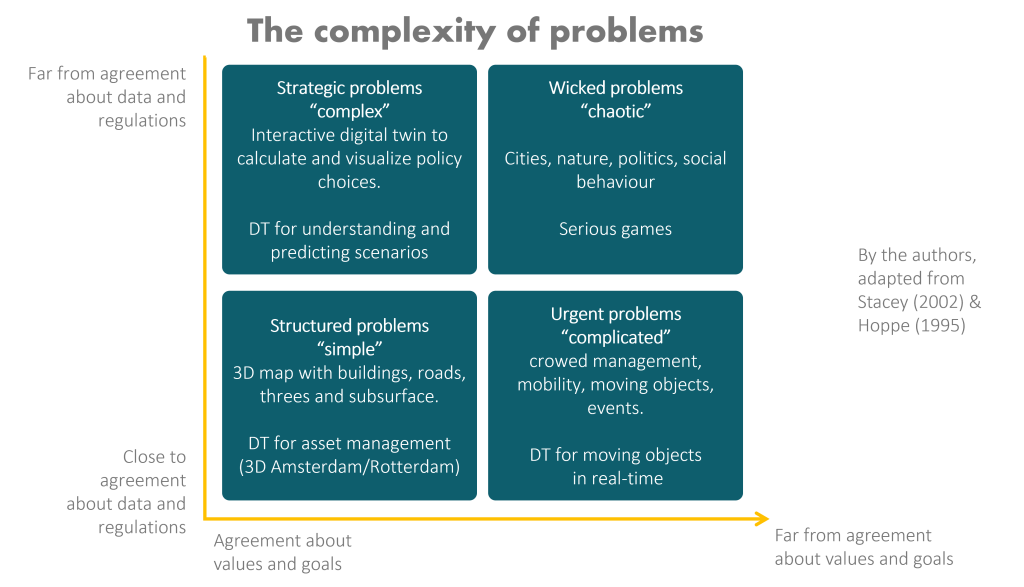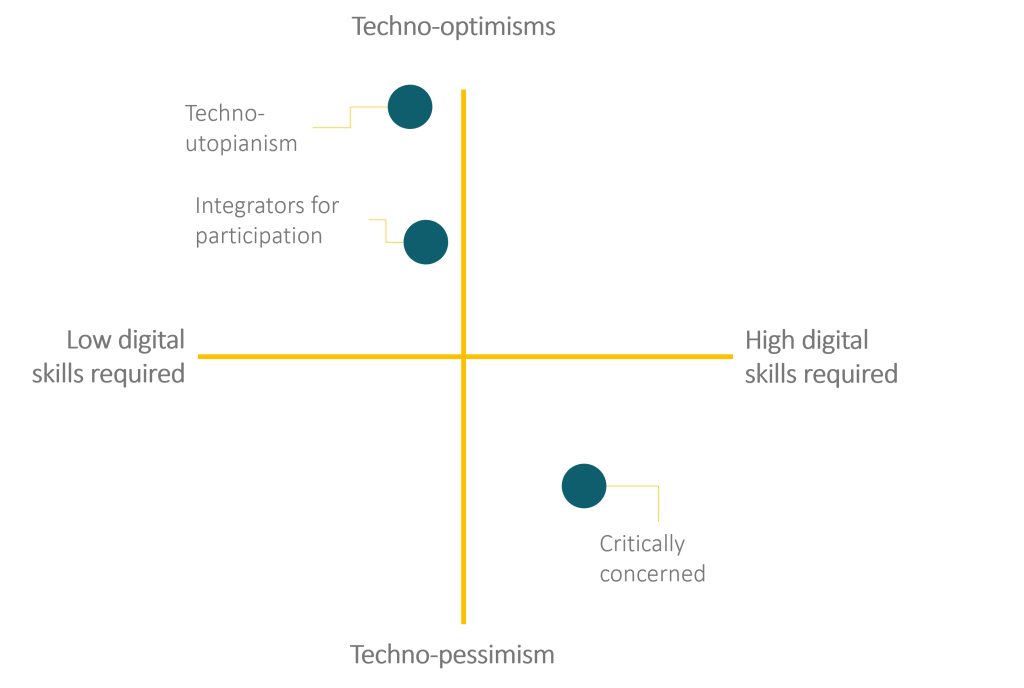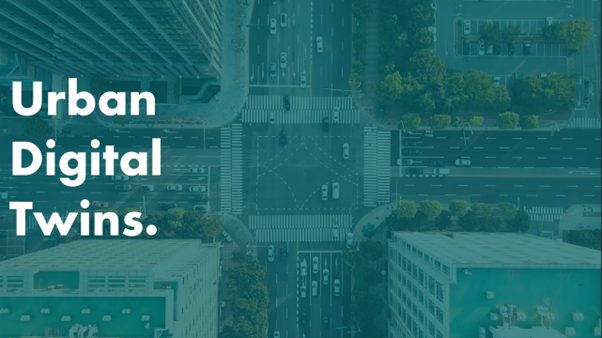Planning has become increasingly complex. More and more functions need to be accommodated in the same number of square meters. This problem lies at the root of the housing crisis, the nitrogen and climate crises. There is no longer a person who oversees the entire system, raising the question: could digital twins contribute to the solution? This has been investigated for BrabantStad by Breda University of Applied Sciences (BUas) through three steps and six sub-questions.
Complex world and concepts – what are digital twins?
- What does the urban digital twin pipeline look like? The urban digital twin pipeline consists of six steps for developing urban digital twins: data collection and data spaces are the basic requirements, while in practice, the other steps are often combined under the heading “urban digital twins.” Four types of digital twins can be defined according to Boyes & Watson (2022) :
Digital models: Visualizing static information with manual data flows.
Digital generators: Automatic simulations based on manual data input.
Digital shadows: Use real-time data with manual interpretation.
Autonomous digital twins: Fully autonomous simulation.

This hierarchy means that each step builds on the underlying techniques, from visualizing to simulating, partially automating to fully automating, and adding new functionalities at each step. The choice of the correct level depends on the purpose, use and complexity of the system to be modelled.
How are urban digital twins concretely applied in the Netherlands, and how do these applications connect to the different steps of the digital twin pipeline? To answer this question, we looked at 22 examples of urban digital twins in the Netherlands. What is striking is that 13 twins are actually digital models, 2 are digital generators and 7 use real-time data and, therefore, fall into the digital shadow category. No urban digital twins that operate completely autonomously have been found. When looking at the needs of end users, it appears that the current offering cannot yet meet the information needs.
What kind of complexity can the current generation of urban digital twins handle? The modified Cynefin Framework (Stacey, 2002) was used to answer this question. This framework distinguishes four domains. In ” Simple “, with clear agreement of values and goals and reasonable certainty of data, we mainly work on digital models to visualise static objects. ” Complex ” is about the future through digital generators for iterative simulations for policy choices, for example. For this, you need consensus on the values and goals. Future data is, by definition, uncertain because it concerns the future, but fortunately, validated historical data can provide insight. In “ Complicated,” digital shadows use real-time data and simulations to identify hidden cause-and-effect relationships, from moving objects like people and traffic to changing contexts like weather. Autonomous digital twins are only suitable for domains with high agreement, data certainty and limited risk. Issues with low agreement on values and goals and low agreement on data and rules are difficult to simulate with an urban digital twin. Policy issues such as the housing crisis benefit from consensus to be able to simulate meaningfully in an urban digital twin. A digital generator that provides insight into integral complex problems best meets these needs.

Making (common) sense of urban digital twins
What perceptions do policymakers, academics and companies have about the impact and value of urban digital twins – What are the similarities and differences in perceptions? This was investigated using a Q study. For this purpose, 29 participants from governments, companies and knowledge institutions were interviewed. This has resulted in three dominant views on urban digital twins:
Techno-utopianism: This group sees urban digital twins as powerful tools for better decision-making and emphasizes collaboration between the public and private sectors. They believe that urban digital twins can have a positive impact but may have little insight into the limitations.
Critical perspective: Critics are concerned that urban digital twins are not neutral and doubt the quality of data, which, in their view, makes urban digital twins of limited use for decision-making. They emphasize the need for ethical research and user education.
Integrators: This group sees urban digital twins as digital copies of real objects and emphasizes 3D visualization and data harmonization. They are less concerned about data quality.
All views are right in certain areas. The utopians are often the drivers of development; the critical perspective is aware of the risks, but construction also needs to happen. These are usually the integrators. These three visions can help to illuminate the further development of urban digital twins from different perspectives.

What urban digital twin development needs are there in North Brabant? The 29 participants were asked about which issues they think urban digital twins can contribute to their work. Six overarching categories have been defined from this: 26% need an integrated approach to issues and coordination with stakeholders, 21% Citizen participation and transparency, 17% Best practices and awareness, 15% Joint data space and data-driven working, 13% Cycling, mobility and transport and 9% need more insight into water storage, heat stress and energy (9%).
How do we move forward?
Which cases are interesting for the future? Based on the conceptual frameworks, the frames and the needs, 5 cases have been defined for further research:
Tiny City Twins: a way to generate data cheaply through portable hardware that can map a different part of the city each time.
BUrDS View: a digital model focused on residential construction.
URBAN-PASS: a digital model with an interface like that in the popular The Sims™ 4 game, aimed at citizen participation.
DIGI-URBAN: a digital generator aimed at developing different scenarios for housing construction.
DIALOGUE: a prompt-based Artificial Intelligence urban digital twin interface, trained on the data in the digital twin.
These cases can be used separately or together, for example, in the Digital Europe call: Data Spaces and smart communities. This call has not yet been published, so it is not yet certain whether these cases meet the call.
This study investigated whether digital twins can contribute to a solution to the space problem outlined. The answer is yes, but there is still work to be done. Urban digital twins are complex and expensive, and no one has found the golden egg. However, given the costs and complexity, it is certain that collaboration is necessary to move forward. This study and the cases provide a starting point for this.

